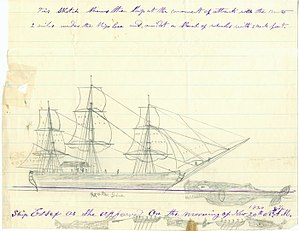 A whale striking Essex on November 20, 1820, depicted in a sketch by Thomas Nickerson
| |
| History | |
|---|---|
| Name | Essex |
| Laid down | Amesbury, Massachusetts,[1] U.S. |
| Launched | 1799[1] |
| Fate | Attacked and sunk by a sperm whale, November 20, 1820 |
| General characteristics [2] | |
| Type | Whaler |
| Tons burthen | 238 72⁄95 (bm) |
| Length | 87 ft 7 in (26.7 m) |
| Beam | 24 ft 0 in (7.3 m) |
| Depth | 12 ft 6 in (3.8 m) |
| Notes | Four whaleboats, 20–30 feet (6.1–9.1 m), plus one spare |
Essex was an American whaling ship from Nantucket, Massachusetts, which was launched in 1799. On November 20, 1820, while at sea in the southern Pacific Ocean under the command of Captain George Pollard Jr., the ship was attacked and sunk by a sperm whale. About 2,000 nautical miles (3,700 km) from the coast of South America, the 20-man crew was forced to make for land in three whaleboats with what food and water they could salvage from the wreck.
After a month at sea the crew landed on the uninhabited Henderson Island. Three men elected to stay on the island, from which they were rescued in April 1821, while the remaining seventeen set off again for the coast of South America. The men suffered severe dehydration, starvation and exposure on the open ocean, and the survivors eventually resorted to cannibalism. By the time they were rescued in February 1821, three months after the sinking of Essex, only five of the seventeen were alive.
First mate Owen Chase and cabin boy Thomas Nickerson later wrote accounts of the ordeal. The tragedy attracted international attention, and inspired Herman Melville to write his 1851 novel, Moby-Dick.
- ^ a b "Essex (whaler)". National Maritime Digital Library. Archived from the original on 3 April 2016. Retrieved 27 January 2015.
- ^ Heffernan 1990, pp. 9–10